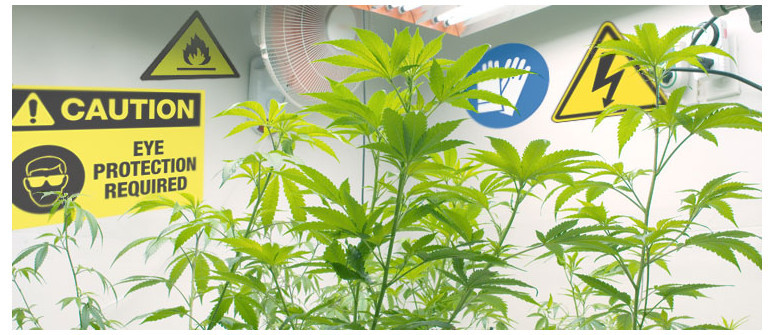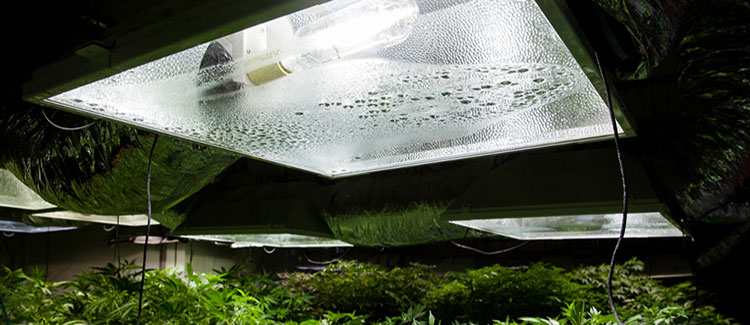Want to grow your own weed? Safety first!

Safety is a vital topic for any cannabis grower, especially those who are working indoors. Check out these 7 simple safety tips for anyone looking to grow weed.
Safety is a vital topic for any cannabis grower, especially those who are working indoors. The equipment you find in most grow rooms can pose some safety hazards when not handled properly; big pieces of equipment can cause fires when they’re not running properly, and chemicals found in fertilizers can damage your eyes, lungs, and skin.
Below are 7 simple safety tips for anyone looking to grow weed.
1. USE HIGH-QUALITY EQUIPMENT
Whenever and wherever you grow, make sure you’re using high-quality equipment. Even if you’re working with a small budget, equipment is not the area where you want to cut corners.
Whether it’s your grow lights, your extractors, or the reflectors you’re using, ensure you always install the best possible equipment you can afford. There’s plenty of great products available at relatively accessible prices, so take the time to shop around and get something professional within your price range.
Dodgy equipment can lead to power outages, short circuits, or even worse, fires. It’s not unheard of for a grow room to go up in smoke thanks to a cheap lighting system or malfunctioning extractor.
2. KEEP YOUR GROW ROOM CLEAN
Keeping your grow room clean is super important. So make sure that cleanliness is embedded into your grow plan right from the get-go. The best way to do this is to draft a regular cleaning routine and follow it right from the beginning.
We generally recommend cleaning your grow room at least once per week, depending on the size of it. And take an extra 10 minutes after you’ve worked on your plants to do a quick clean up.
Clean up any spills immediately, properly store all your equipment, and keep all your nutrients tightly sealed. Also, wipe down any benches and check that all your equipment is running smoothly.
Then, on your dedicated cleaning day, make sure to do a thorough clean of your entire grow space. Take the plants out of the room and clean the floor, all your work benches, storage containers, shelves, etc. Once you’ve cleaned everything, bring your plants back in and set everything up as it was.
3. BE CAREFUL WITH HID LIGHTING

High-pressure sodium lights, as well as other types of HID glow lights, are known to get really hot. If you install this kind of lighting in your grow space, you will need a way to exhaust the hot air generated by the lamps. Not only will it affect the health of your plants, but hot environments also increase the risk of fire.
Also, make sure your lights are well above the tips of your plants. If you’re growing sativas, pay extra attention as they tend to “reach” for the light more than indicas.
Finally, be sure to shield your eyes. Extended exposure to high-pressure sodium lights and other HIDs is known to damage the eyes. LEDs, metal halide, and any other lights capable of producing UVA, UVB, and UVC rays will also irritate and damage your eyes over time.
Hence, remember to invest in a good pair of glasses designed to be used in indoor gardening setups. They’ll protect your eyes and make you less likely to experience headaches and other kinds of irritation.
4. BE PREPARED FOR A FIRE
Sorry to burst your bubble, but it's true; when you grow indoors, you’re at risk of causing a fire. Yes, you can diminish this risk close to 100% in a number of ways, but there’ll always be a minor risk that you need to be aware of.
So, that being the case, make sure you’re adequately prepared for a fire should one break out. Always keep a fire extinguisher in your grow area and learn how to properly operate it. Also, it’s a good idea to keep a torch next to the extinguisher should your lights go out.
5. BE CAREFUL WITH YOUR ELECTRICITY
Growing weed takes up a lot of electricity. The power needed to run all your equipment can easily overload a circuit, stress out cables, or overload power points. Invest in high-quality electrical equipment, like heavy duty cables and reliable ballasts, proper connectors, etc.
Also, try to keep as many electrical cables off the floor as possible. This will help reduce the possibility of a fire from a spill, and also diminishes the risk of tripping/falling. Remember, a trip or fall can lead to knocking over equipment, which can damage your equipment and plants, or worse, cause a fire.
6. PROTECT YOUR EYES AND SKIN
Last but not least, remember to protect your body whenever you’re working in your grow room. It's a good idea to wear a separate pair of clothes that cover most of your body to protect your skin against any harsh chemicals in fertilizers or pH-balancers.
If you want to be on the safe side you should also use proper safety goggles when handling any kind of chemical nutrient solution or fertilizer. If they happen to get in your eyes, the chemicals in these solutions can cause some serious damage (sometimes even blindness).
7. STAY SAFE FROM THE COPS, NEIGHBORS, ETC.
Last, but certainly not least... The law. The law on cannabis is slowly changing. Unfortunately, there are still many places where using, possessing, or cultivating cannabis remains illegal. In many of these places, cultivating can attract harsh penalties resulting in fines or even jail time.
Before you start your first grow, make sure you're well aware of the law surrounding cannabis. If you happen to live in an area where growing weed is legal, take your time to get to know the law and make sure you're abiding by it. This might restrict the number of plants you're able to grow or the equipment you're allowed to use, but hey, it's better than ending up behind bars, right?
If you're planning to grow in a place where it's illegal to do so, make sure you avoid attracting any unwanted attention. Don't tell anyone that you're growing, and make sure you're operating out of a location where you're least likely to annoy neighbors with grow lights, the sound of your equipment, or the smell of your plants.
Here are some tips to help you avoid attracting the attention of neighbors, cops, or anyone else who might undermine your operation:
- Keep your plants out of sight
- Keep your extractors away from your neighbors' windows
- Avoid attracting attention from light leaks if running your grow lights overnight
- Avoid growing in residential areas or places that are highly trafficked
.jpg)
.jpg)

.jpg)
